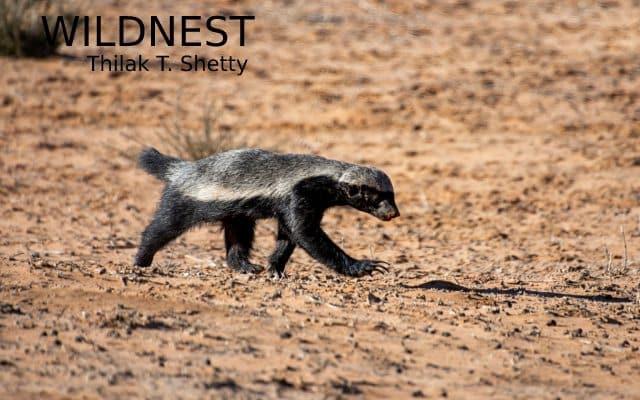The honey badger, also known as the ratel, is a medium-sized mammal in the mustelid family. It is the largest terrestrial mammal found in Africa. Despite its name, the honey badger does not closely resemble other badger species; instead, it bears more anatomical similarities to weasels. It is primarily a carnivorous species and has few natural predators because of its thick skin, strength and ferocious defensive abilities.
The honey badger has a fairly long body but is distinctly thick-set and broad across the back. Its skin is remarkably loose, and allows the animal to turn and twist freely within it the skin around the neck is 6 mm thick, an adaptation to fighting conspecifics. The head is small and flat, with a short muzzle. The eyes are small, and the ears are little more than ridges on the skin, another possible adaptation to avoiding damage while fighting. The honey badger has short and sturdy legs, with five toes on each foot. The feet are armed with very strong claws, which are short on the hind legs and remarkably long on the forelimbs. It is a partially plantigrade animal whose soles are thickly padded and naked up to the wrists. The tail is short and is covered in long hairs, save for below the base.
The honey badger does not have a particularly specialised diet. It is an omnivore, feeding on a wide range of foods including raiding beehives for both bee larvae and honey, as well as feeding on rodents, amphibians, birds, eggs, berries, roots, and bulbs. It will even kill and eat black mambas, a highly venomous snake. The species will also steal food from other carnivores, or scavenge from kills. Although it feeds predominantly on soft foods, the honey badger’s cheek teeth are often extensively worn. The canine teeth are exceptionally short for carnivores. The papillae of the tongue are sharp and pointed, which assists in processing tough foods.
The honey badger is the largest terrestrial mustelid in Africa. Adults measure 23 to 28 cm. in shoulder height and 55–77 cm in body length, with the tail adding another 12–30 cm. Females are smaller than males. In Africa, males weigh 9 to 16 kg while females weigh 5 to 10 kg on average. The mean weight of adult honey badgers from different areas has been reported at anywhere between 6.4 to 12 kg, with a median of roughly 9 kg, per various studies. The skull greatly resembles a larger version of that of a marbled polecat. The teeth often display signs of irregular development, with some teeth being exceptionally small, set at unusual angles or absent altogether.
The honey badger ranges through most of sub-Saharan Africa, from the Western Cape, and South Africa, to southern Morocco and southwestern Algeria and outside Africa through Arabia, Iran, and Western Asia to Turkmenistan and the Indian Peninsula.
The honey badger is notorious for its strength, ferocity, and toughness. It is known to attack almost savagely and fearlessly any other species when escape is impossible, reportedly even repelling much larger predators such as lions and hyenas. Because of the toughness and looseness of their skin, honey badgers are very difficult to kill with dogs. The only safe grip on a honey badger is on the back of the neck.
Little is known about the honey badger’s breeding habits. Its gestation period is thought to last six months, usually resulting in two cubs, which are born blind. Its lifespan in the wild is unknown, though captive individuals have been known to live for approximately 24 years. When mating, males emit loud grunting sounds. Cubs vocalise through plaintive whines. When confronting dogs, honey badgers scream like bear cubs.
The honey badger has also been reported to dig up human corpses in India. In Kenya, the honey badger is a major reservoir of rabies and is suspected to be a significant contributor to the sylvatic cycle of the disease.



















